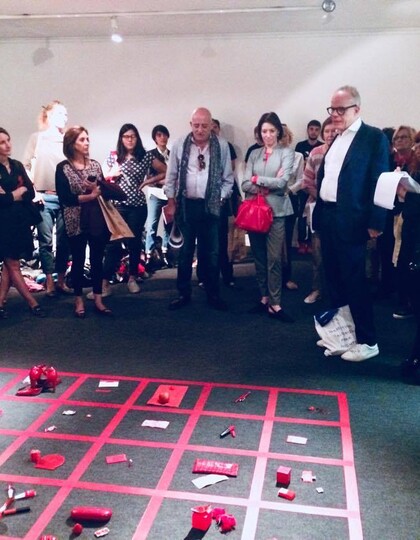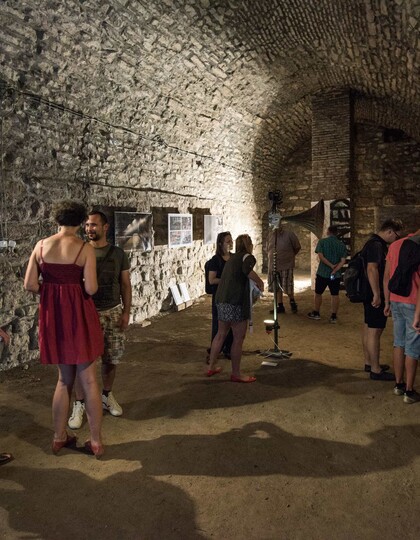Emese Zsuzsa Molnár
area: Art and Activism, Artivism, Theory, Curating
Key Facts
nationality
Romaniaarea
Art and Activism, Artivism, Theory, Curatingresidence
Miercurea Ciucrecommending institution
tranzit.org/ERSTE Stiftungtime period
April 2019 - April 2019Emese Zsuzsa Molnár (1986 Miercurea Ciuc, Romania) is a sociologist by training with a professional interest and formation on the crossroads of intersecting fields from the more theoretical such as gender and equal opportunities studies, towards the more performative like art and activism. In the past two years she has been a fellow of the Hungarian-Argentinean exchange program of the Argentine Ministry of Education, completing her MA in Curatorial Studies in Visual Arts (Curaduría en Artes Visuales) at the National University of Tres de Febrero (UNTREF) in Buenos Aires, Argentina.
As a production assistant she participated in the organization, production and montage of the exhibition “Take Me, I´m Yours” curated by Hans Ulrich Obrist and Christian Boltanski in the framework of BIENALSUR, the International Biennial of Contemporary Art of South America organized by UNTREF in 2017 in Buenos Aires, Argentina.
As a more recent experience she contributed to the collective exhibition “100 Years of Parallel Dialouge” which took place at the Art Museum of Cluj in august 2018, reflecting on the transformative changes of the past decades that affected the different ethnic groups living together in the region. In the framework of the MIMESIS exhibition she curated the works of photographer Zágon Szentes on changing identities in the context of migrating masses seeking for better opportunities or for a living in general, across the globe.
Molnár comes from the field of social inclusion and empowerment, having worked 4 years at the Open Society Foundations in Budapest, Hungary. Within the Roma Initiatives program her greatest contribution was the organization of professional meetings and conferences around the theme of anti-gypsyism that led to the founding of the European Roma Institute for Arts and Culture (ERIAC), the first Romani cultural institute with the main headquarters in Berlin.
She participated in several socio-cultural development projects implemented by ITD / CEPS Projectes Sociales in Barcelona, Spain working on issues of migration, social participation, European capitals of culture and storytelling. In 2011 she was part of the organizing committee of the International Theatre Festival "Interferences" held at the Hungarian Theater in Cluj, Romania.
In general as a researcher and curator I am interested in artistic works that are defined by different attempts to decentralize power and question its given forms. The main purpose of my stay is to contribute to the study and understanding of contemporary (and historically contemporary) artistic practices in which art expresses itself through beauty, purity of forms and harmony, but also unpleasantness and of criticism (social and political). I plan to focus on investigating the ways in which artistic creativity can play a central role in the transformation of society, or can create a space for criticism and reflection on the societies in which we live in and on their ideological foundations. It is a look at how the limits of art are regulated, a search for the permanent tension between the poetic and the political, between the social and the artistic.
My goal is to present a proposal that has a critical capacity, in terms of Didi-Huberman to create "a dialectical place", a so-called "denkraum", that works as a "war machine": that is, it has the potential to invite people to think and to reflect critically, because, paraphrasing Marie Orensanz, I am deeply convinced that "thinking is a revolutionary act[1]".
[1] Public work of Marie Orensanz, “Pensar es un hecho revolucionario” in the “Parque de la Memoria” in Buenos Aires, Argentina
As someone belonging to the generation which first and utmost is looking to find a meaning in everything we do, I believe or I am convincing myself to the level of belief about the transformative character of art which by leaving behind the categories of normality it is capable to modify the scheme of reality. Interventions, transformations, public space, community, talking from within or outside the system, social issues, political grounds, activism – to only mention a few buzzwords which are likely to come up in current discourses about the art of the contemporary – I believe one of the roles of such residency programs can be to serve as laboratory of ideas. In this sense and as I could experience throughout my one-month stay at the MuseumsQuartier in Vienna, the city itself and the cultural institutions present in it, offer an extremely wide range of possibilities to explore, participate, criticize, create, learn, visit, study, think and initiate. To me personally it served as a thinking space where I could visit as much as exhibitions as I wanted, got acquainted to a network of contemporary thinkers whose work I started to admire and it made possible that I got familiar with some books and readings for which otherwise I have difficulties to finding the time throughout the year.
On a personal level, I find it very important to mention the connections I could establish in Vienna which can possibly lead to further collaborations in the future and I am especially grateful for the rich conversations with my neighbor at MQ, artist in residence from the US, Franklin Einspruch who have later this year visited me in Budapest, Hungary. Also, thanks to Michaela Geboltsberger from Tranzit Austria Foundation, I met young curators active in the Vienna contemporary scene and also other artists not part of the residency program but close to the Tranzit network from Slovenia to Slovakia.
On an institutional level, this brings me to a professionally significant knowledge I could gain about the Tranzit network of civic associations working independently in the field of contemporary art in Austria, the Czech Republic, Hungary, Slovakia and Romania and besides Tranzit Austria I could visit and meet the director of Tranzit Slovakia as well. Two of the most impressive and exciting experiences from my residency are linked to Tranzit and the Erste Foundation behind it. Let me mention the guided tour called “Art in Architecture” at Erste Campus, which proved to be not only a great opportunity to explore this interconnectedness between the business sector, contemporary art and architecture, combined with elements and thoughts on the XXIst century working places and work-life balance, but also shed light on the amazing art collection the Erste Foundation manages. Previously I was unfamiliar with the Kontakt Collection and getting to know more about its content but also aims and objectives, was a huge learning to me relating back to one of my preferred topics on art, politics and activism in Eastern Europe after 1989.
Thankfully to the very welcoming atmosphere at Erste in the person of Heide Wihrheim I came back home with a bunch of handful books, with a subscription to their prestigious library and also with the Kontakt Collection catalogue for which I am truly grateful.
Most of my time in Vienna I spent with visiting exhibitions, both in large institutions, museums as well as in small galleries and alternative spaces and walked a lot on the streets of Vienna and documented artistic interventions in the public spaces: street art, murals across the Danube and at squares, parks, etc. Because of lack of time and shorter stay as previously planned, I did not get acquainted with all the members of my cohort, artists in residence at MQ, but I found it important and helpful that MQ organized regular get-togethers, guided tours and presentations so to have a taste of others’ works and projects.

















